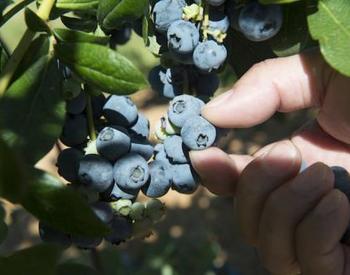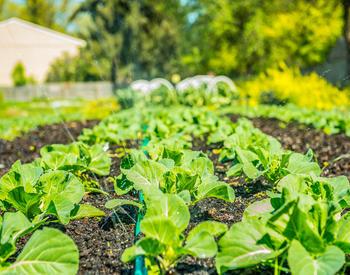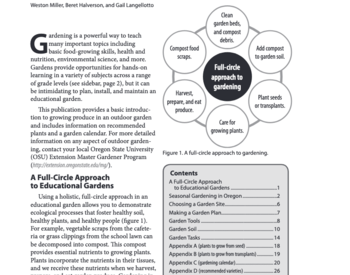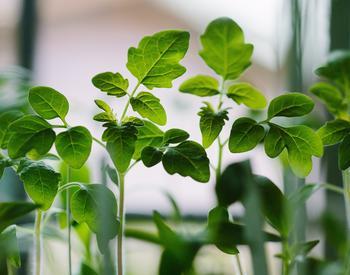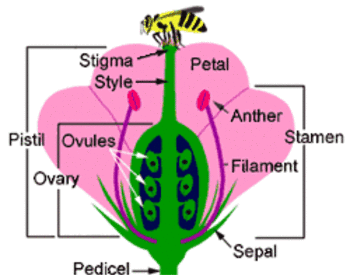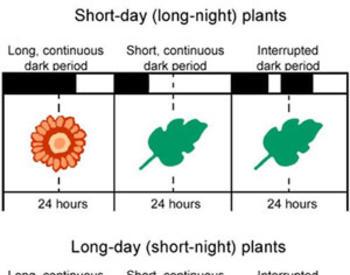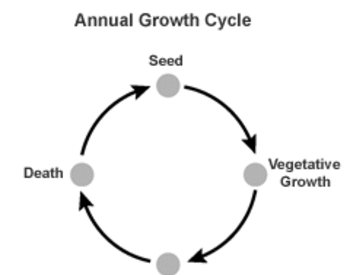Transcript
249_how_to_buy_a_native_plant_Mixdown_1
Andony Melathopoulos: [00:00:00] The Oregon State University Extension Service, This is Pollination, a podcast that tells the stories of researchers, land managers, and people like you who are making bold strides to improve the health of pollinators. I'm your host, Dr. Adoni Malathopoulos, Associate Professor of Pollinator Health in the Department of Horticulture.
I'm super excited to get this podcast all done, recorded, and uploaded because I have some native shrubs. That I've been gathering over the last month and I'm going to plant them today. I've done my sheet mulching. Everything's ready and they're going to be going in. Fall is a great time to be planting native shrubs.
But maybe you're getting catalogs in the mail. You're thinking forward and you're, you're really bewildered. Native plants, like how do I, how do I buy a native plant? Well, fear not this week. We're going to go down the hallway to the garden ecology [00:01:00] lab here at Oregon state university, and we're going to be hearing from Jen Hayes.
Now, many of you might remember Jen from a previous episode. She's a PhD candidate here in horticulture, concentrating in entomology. And Jen has been working on native plants and nativars. You can go back and hear that episode, but she's also just, uh, developed a new card information card that's going to be available, um, uh, through the be advocates program freely to anybody in Oregon, uh, to learn how to, uh, identify a native plant.
So in this episode, she's going to be joined by a. Guest host, Nicole Bell, who's going to be the guest next week. It's so exciting, but before we get rolling, I do want to mention the garden ecology lab at Oregon state university has a new website. You should check it out. And also there is a survey going on, um, on native plants.
I really encourage all of you to stop the recording and take the survey. You can access it at the following website. So type [00:02:00] in the letters, B I T dot L Y. Backslash G E L, that's Garden Ecology Lab, so G E L, plant survey. But you'll also find it on their website if you go to the bottom of their page. It is GardenEcology.
OregonState. edu. So without further ado, let's try and... Uh, untangle the bewildering world of native plants this week with Jen Hayes and guest host Nicole Bell.
Nicole Bell: Welcome to Polynation. I'm your guest host today, Nicole Bell from the Garden Ecology Lab at Oregon State University. I am a graduate research assistant and I'm joined today by one of my fellow graduate research assistants. It's
Jen Hayes: me, [00:03:00] Jen. Jen Hayes. And
Nicole Bell: To set the scene, we're here sitting on my back patio.
This is actually my childhood backyard. It is 75 degrees and we were listening to the buzzing of some bees and small carpenter bees, but it's really been overshadowed by the blue jays in the last 10 minutes. So you might hear some chirping. and buzzing in the background. So we're here today to talk about Jen's work on deciphering the language of native plant tags, which as I've learned over the past couple of years is It's very complex, and it can be a really confusing process when you're looking to buy a native plant.
But let's start with the basics. Jen,
Jen Hayes: what is a native plant? So I like to use an official definition when I tell people. So this one [00:04:00]comes from the Natural Resources Conservation Service. Native plants are the indigenous terrestrial and aquatic species that have evolved and occur naturally in a particular region, ecosystem, and habitat.
Species native to North America are generally recognized as those occurring on the continent prior to European settlement. They represent a number of different life forms, including conifer trees, hardwood trees, and shrubs, grasses, forbs, and others. But... There are different scales that we can consider plants to be native to, which might actually alter how someone talks about native plants.
So you could say that something is broadly native to North America, or you could narrow it down and say, like, this plant is native to the United States, the Pacific Northwest, Oregon, or even the Willamette Valley.
Nicole Bell: Wow. Okay, so lots of levels there. And why would someone want to buy a native plant in the first place?
Jen Hayes: Let me [00:05:00] count the ways. There's so many different reasons that someone may want to buy a native plant. So a lot of folks right now are really interested in ecological gardening or planting native plants for native wildlife like bees, butterflies, and birds, or planting gardens that mimic the natural landscapes that their garden is situated in.
Native plants are often better adapted to the environment that they're native to as well, so that could reduce the amount of management that you might need in your garden, like reducing irrigation and other things. So choosing native plants is a great way to potentially increase the longevity of your planting.
Especially if you think about, um, if you live in Eastern Oregon, for example, and you want to plant a cherry tree for its beautiful spring flowers, a cherry tree that is native to Oregon will probably be hardier to the winters in this region compared to if you got a cherry tree from a [00:06:00] nursery in Georgia and planted it there.
Nicole Bell: Okay, so why might I need help buying a native plant? What's so, where does the confusion arise?
Jen Hayes: So believe it or not, finding and buying native plants is really not always as easy as walking into any random garden store. It can actually be really difficult or really confusing to buy native plants. So, for example, for my research project, I had to locate eight different native plants in relatively high quantities.
And what I encountered during that process was inconsistency in labeling and the use of native terminology, um, especially when reading plant tags versus bags of seed and even how plants are described on websites. So on some websites, I would use a little. filter for native plants and the plants returned would often be a mix of wild types and cultivars.
Nicole Bell: So for those of us that don't [00:07:00] know, what is a wild type native plant and how is that different from a
Jen Hayes: cultivar? So a wild type is the form of a plant that occurs. in wild populations versus a cultivar is short for cultivated variety. And those are forms of plants that are developed by people rather than those that are naturally occurring.
Sometimes cultivars are developed from naturally occurring varieties. So like if you've ever seen a beautiful field of camas. it's usually very, very purple, except you might see one or two white flowered stems. So that's an example of a naturally occurring form that someone could develop into a cultivar through selective breeding, um, and propagation methods.
Um, but in particular, cultivars are bred to be distinct, uniform, and stable, and they also have a name. So a cultivar name is listed in single [00:08:00] quotation marks following the scientific name of a plant. So for example, Um, there is a, uh, yellow cultivar of yarrow that is really common around Corvallis, and the name of that plant is Achillea moonshine.
So the genus is Achillea, and then moonshine is the name given to that cultivar.
Nicole Bell: Okay, so it's a lot more complicated than I know I thought ever before I learned about this. So tell me what you've done to help make buying native plants easier.
Jen Hayes: So I've created two handouts to help navigate some of the confusion when it comes to buying wild type native plants.
The first is a pocket guide which walks through how to read plant labels and tell cultivars from subspecies. species from varieties, et cetera. And then the [00:09:00] second is a little bit longer and it actually walks through some resources you can use to find out if a plant is native to your region. It has a bunch of examples on how to read plant labels, and then also some guidance related to buying regionally adapted or genetically diverse plants.
Nicole Bell: Okay, need this in my life. How can I access it?
Jen Hayes: Where can we find it? So, both the pocket guide and the longer handout can be found on our lab's website. So, the Garden Ecology Lab's website, which is gardenecologylab. oregon. ca state. edu. We'll also put this in the show notes. And then the pocket guide will also be circulated at in person events held by both our lab and the pollinator health lab.
Amazing.
Nicole Bell: So I'm in my car, I'm zooming to the local nursery. Walk me through what it might look like if I want to buy Clarkia, aka
Jen Hayes: farewell to spring. So, your experience is [00:10:00] going to depend, again, whether you're shopping online or in person, and whether you're looking for... a potted plant or seed. So, I already know that Clarkia is native to the Willamette Valley, but if I wanted to double check, I would probably look at the USDA Plants Database and Oregon Flora.
So, I would look at the pictures on these websites to familiarize myself with what the native plant looks like in case I come across some cultivars during my search. And actually, since Clarkia is an annual, And I don't have a lot of time on my hands. I would probably actually just buy some seed online.
So I would go to my favorite nursery's website and search the scientific name of the plant into their little search bar. So in this case, I would type Clarkia ammoyna. Um, and then I would click on the result that has a picture of the plant that looks like the wild type and see if the description mentions anything about native status or [00:11:00] otherwise.
For my own garden, I'm not really picky about where the seed was grown, but website descriptions are really great to read through if you do want to know more about the seed you're buying. And one other tricky thing I found on sites that do sell cultivars is the description will still say Oregon native plant.
Which like... isn't not true because it is originating from a native plant. It's just not, um, usually the shape or color that we would find in wild populations. But this is where knowing what your plant is supposed to look like is helpful and also knowing how to read plant labels. So, I know that cultivars have names, so on this page I would look for a name in single quotation marks.
If I came across something like Dwarf White or Scarlet after the scientific name, then I would know it's a cultivar. But if the picture matches what I'm looking for and there's no cultivar name and no mention of breeding for other [00:12:00] traits, I would go ahead and order it. Great.
Nicole Bell: So, what's a key takeaway that people should know about buying native plants?
Jen Hayes: So, I'm in a lot of gardening groups on social media, and I think in this community, there's really a need for a black and white answer about what the best thing to do in your garden is. But I think something that I've actually taken away from my five years as a graduate student is that there really is no one rate.
Right way to garden, especially when it comes to native plants and cultivars. Native cultivars are not evil And if your goal is to plant for wildlife Ooh, like this hummingbird that just flew by us. We've been visited Then you might choose wild types over cultivars But if for example you absolutely love California poppy and you want your garden to be basically just a rainbow of different colors of California poppy, that is [00:13:00] also totally valid and totally wonderful.
Yeah,
Nicole Bell: and just for an example of that, the patio we're sitting on right now is very much a mix of native, non native plants. Um, we've got a goldenrod right next to us that's finishing up, but we also have plenty of non native plants that we really just like and enjoy. So, you can really make decisions about what makes you happy in your garden and still do a great job for pollinators and the environment at the same time.
Yeah,
Jen Hayes: you definitely don't have to do all one thing. I think it's really wonderful when people include plants that are meaningful to them in their garden, not just plants. that are maybe the most suitable ecological choice. Right.
Nicole Bell: So I need to know what are your favorite cultivar
Jen Hayes: names. So some cultivar names are absolutely fabulous.
This isn't a native plant example, but there's a butterfly bush called, um, Flutterby [00:14:00] Petite Tutti Frutti. Amazing. Which is, yeah. Just absolutely fantastic. Um, but there's also a yarrow that's called Strawberry Seduction. Love her. Um, I think it's really fun when the Cult of Our Name tells you something about the plant versus those that are just named after a person or...
Some otherwise arbitrary combination of words.
Nicole Bell: Yeah, some of the names out there are really creative.
Jen Hayes: Um,
Nicole Bell: so you can only choose three native plant species for your garden for the rest of your life. Which three? Are you choosing, and
Jen Hayes: why? Um, so this is actually pretty easy for me. Um, I would choose a purple aster.
It would depend what coast I'm on. I'm from Vermont, so if I was in New England, I would go for the lovely New England aster. But since we're in Oregon, I would go for Douglas aster. Um, and then also goldenrod, because the two of those plants together is... Mwah! Chef's kiss. Absolutely [00:15:00] beautiful. Purple and yellow.
What more could you want? Actually, what more you could want is number three, which is Farewell to Spring or Clarkia amelina. It's a glorious little annual, and my selling point for people, especially those who like ecological gardening, is that if you plant Clarkia, odds are very high that some leafcutter bees will come and steal pieces of the petals.
So that's one plant that you can put in your garden and almost immediately see the beneficial impact it's having on pollinators.
Nicole Bell: And I'll add there's nothing cuter than watching a leaf cutter bee use its little mandibles to cut a little crescent in the flower and fly away with it. So if you're lucky enough to see that, I don't know what to tell you other than you need to plant
Jen Hayes: Clarkia in your garden.
Bee confetti. Bee confetti. So, is there anything else you want people to know? Um, I don't think so. Both my guides will be available on our [00:16:00] website and the handouts will be around. All right. Well,
Nicole Bell: thanks for being here, Jen. Again, this has been Nicole and Jen featuring the Garden Ecology Lab takeover of the Pollination Podcast.
So thank you for listening and
Jen Hayes: have a great month. Have a beautiful day. Bye. See some bees.
Andony Melathopoulos: Thank you so much for listening. Show notes with links from each episode are available at the website pollinationpodcast. oregonstate. edu. I also love hearing from you and there's a form at the website where you can pop in and say hello and give me feedback. If you want to support the show remember to leave a rating on iTunes, Spotify, or whatever podcast mothership you use.
And finally, if you have the means and you want to help support my lab's effort to document bee biodiversity in Oregon, visit OregonBeeAtlas. org and follow down to the donate button where you can make a tax [00:17:00] deductible donation to the Jerry and Judith Paul Native Pollinator Endowment. Every little bit helps.
See you next episode.
As nursery catalogs start to show up in our mailboxes and we think about the plants we want to grow next season, it's easy to get overwhelmed. In this episode, guest host Nicole Bell talks with Jen Hayes about two handouts that can help you better understand plant labels and discover if the plant in front of you is a wild-type native plant, a cultivar, or some other plant form! Jen and Nicole are both graduate student members of OSU's Garden Ecology Lab.
Links mentioned:
- Pocket Guide (Reading Plant Labels)
- Longer handout (How to Buy a Native Plant)
- Garden Ecology Lab Website
- Garden Ecology Lab Blog
- You can order the cards mentioned in the episode directly from the Garden Ecology lab, or by becoming an OSU Bee Steward (Advocate)
About our guest:
Jen Hayes is a PhD candidate in Horticulture with a concentration in Entomology. Jen is a Vermonter who is passionate about pollinators; she fell in love with native bees as an undergraduate at the University of Vermont. Since her first exposure to bee research, she has had the opportunity work on pollinator studies in Vermont, Ecuador, North Dakota, and Oregon. She is interested in how human-developed landscapes, such as farms and gardens, can achieve dual goals of pollinator conservation and plant productivity.

